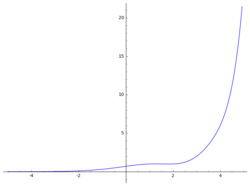Hadamard's gamma function
In mathematics, Hadamard's gamma function, named after Jacques Hadamard, is an extension of the factorial function, different from the classical gamma function (it is an instance of a pseudogamma function.) This function, with its argument shifted down by 1, interpolates the factorial and extends it to real and complex numbers in a different way than Euler's gamma function. It is defined as:
- [math]\displaystyle{ H(x) = \frac{1}{\Gamma (1-x)}\,\dfrac{d}{dx} \left \{ \ln \left ( \frac{\Gamma ( \frac{1}{2}-\frac{x}{2})}{\Gamma (1-\frac{x}{2})}\right ) \right \}, }[/math]
where Γ(x) denotes the classical gamma function. If n is a positive integer, then:
- [math]\displaystyle{ H(n) = \Gamma(n) = (n-1)! }[/math]
Properties
Unlike the classical gamma function, Hadamard's gamma function H(x) is an entire function, i.e. it has no poles in its domain. It satisfies the functional equation
- [math]\displaystyle{ H(x+1) = xH(x) + \frac{1}{\Gamma(1-x)}, }[/math]
with the understanding that [math]\displaystyle{ \tfrac{1}{\Gamma(1-x)} }[/math] is taken to be 0 for positive integer values of x.
Representations
Hadamard's gamma can also be expressed as
- [math]\displaystyle{ H(x)=\frac{\psi\left ( 1 - \frac{x}{2}\right )-\psi\left ( \frac{1}{2} - \frac{x}{2}\right )}{2\Gamma (1-x)} = \frac{\Phi\left(-1, 1, -x\right)}{\Gamma(-x)} }[/math]
where [math]\displaystyle{ \Phi }[/math] is the Lerch zeta function, and as
- [math]\displaystyle{ H(x) = \Gamma(x) \left [ 1 + \frac{\sin (\pi x)}{2\pi} \left \{ \psi \left ( \dfrac{x}{2} \right ) - \psi \left ( \dfrac{x+1}{2} \right ) \right \} \right ], }[/math]
where ψ(x) denotes the digamma function.
References
- Hadamard, M. J. (1894) (in fr), Sur L'Expression Du Produit 1·2·3· · · · ·(n−1) Par Une Fonction Entière, Œuvres de Jacques Hadamard, Centre National de la Recherche Scientifiques, Paris, 1968, http://www.luschny.de/math/factorial/hadamard/HadamardFactorial.pdf
- Srivastava, H. M.; Junesang, Choi (2012). Zeta and Q-Zeta Functions and Associated Series and Integrals. Elsevier insights. pp. 124. ISBN 978-0-12-385218-2.
- "Introduction to the Gamma Function". Wolfram Research, Inc. http://functions.wolfram.com/GammaBetaErf/Gamma/introductions/Gamma/ShowAll.html.
 |


